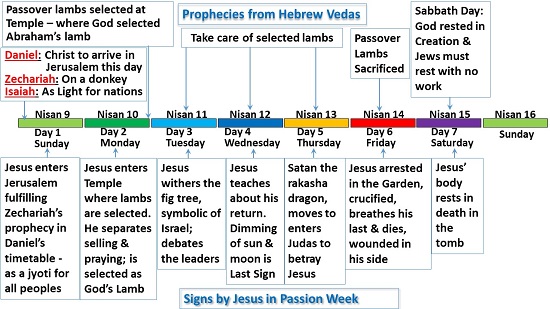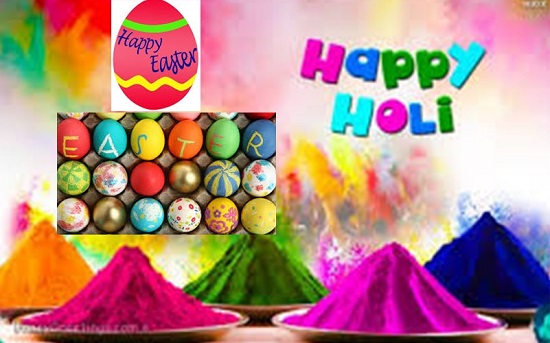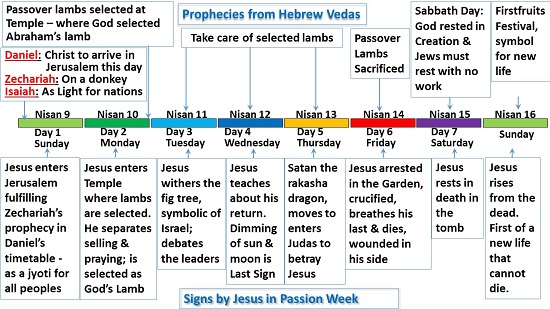We celebrate Holi on the last Full Moon of the Hindu calendar. With its luni-solar origins, Holi moves around in the Western Calendar, generally coming in March, as a joyous festival of spring’s arrival. Though many celebrate Holi, few realize its parallel to First Fruits, and the later celebration derived from it, Easter. These celebrations occur on spring Full moons and so often coincide.
Holi Celebrated
People celebrate Holi as a joyous Festival of Spring, Festival of Love, or Festival of Colours. Its most prominent purpose celebrates the beginning of spring as a harvest rite. Traditional literature, identified Holi as a festival celebrating bountiful spring harvests.
Holi also celebrates the victory of good over evil. Following the evening of Holika Dahan, Holi (or Rangwali Holi, Dhuleti, Dhulandi,or Phagwah) continues the following day.
People celebrate Holi by smearing each other with colours. They also use water guns and water-filled balloons to drench and colour each other. It is like a water fight, but with coloured water. Anyone is fair game, friend or stranger, rich or poor, man or woman, children or elders. The colour extravaganza occurs in open streets, parks, outside temples and buildings. Groups carry drums and musical instruments, going from place to place, singing and dancing. Friends and foes come together to throw coloured powders on each other, laugh, gossip, then share Holi delicacies, food and drinks. By late morning, everyone looks like a canvas of colours, hence the name “Festival of Colours”.
Perhaps most unique of Holi is its social role reversals. A latrine sweeper can hit a Brahmin man and it is all part of the festival’s role reversal. The conventional expressions of love and respect between parents and children, siblings, neighbours, and different castes are all reversed.
Holi Mythology
There are several mythologies behind Holi. The story continuing from Holika Dahan relates the fate of King Hiranyakashipu, with his special powers had schemed to kill Prahlada. He could not be killed: by human nor animal, indoors nor outdoors, at daytime nor night-time, by projectiles nor by handheld weapons, and not on land, water or air. After Holika’s attempt to burn Prahlada failed, Vishnu in the form of Narasimha, half-human and half-lion (neither human nor animal), at dusk (neither day nor night), took Hiranyakashyapu to a doorstep (neither indoors nor outdoors), placed him on his lap (neither land, water nor air), and then eviscerated the king with his lion claws (neither a handheld nor launched weapon). In this story Holi celebrates good over evil.
Similarly, First Fruits celebrates a triumph, but not over a wicked king, but death itself. The Gospel explains how First Fruits, now known as Easter Sunday, make this clear, offering new life to you and me.
Ancient Hebrew Veda Festivals
We followed the daily events of Jesus’ last week. He was crucified on Passover, a sacred Jewish festival, resting in death on the Sabbath, the seventh day of the week. God instituted these holy days long beforehand in the Hebrew Vedas. Those instructions read:
The Lord said to Moses, 2 “Speak to the Israelites and say to them: ‘These are my appointed festivals, the appointed festivals of the Lord, which you are to proclaim as sacred assemblies.
The Sabbath
3 “‘There are six days when you may work, but the seventh day is a day of sabbath rest, a day of sacred assembly. You are not to do any work; wherever you live, it is a sabbath to the Lord.
The Passover and the Festival of Unleavened Bread
4 “‘These are the Lord’s appointed festivals, the sacred assemblies you are to proclaim at their appointed times: 5 The Lord’s Passover begins at twilight on the fourteenth day of the first month.
Leviticus23:1-5
Isn’t it curious that both the crucifixion and rest of Jesus happened exactly on these two Holy festivals prescribed 1500 years beforehand?
Why? What does it mean?

This timing with the ancient Hebrew Veda festivals carries on. The next festival after Passover and Sabbath was ‘First Fruits’. The Hebrew Vedas gave these instructions for it.
Hebrew First Fruits Festival
The Lord said to Moses, 10 “Speak to the Israelites and say to them: ‘When you enter the land I am going to give you and you reap its harvest, bring to the priest a sheaf of the first grain you harvest. 11 He is to wave the sheaf before the Lord so it will be accepted on your behalf; the priest is to wave it on the day after the Sabbath…
Leviticus 23:9-11
You must not eat any bread, or roasted or new grain, until the very day you bring this offering to your God. This is to be a lasting ordinance for the generations to come, wherever you live.
Leviticus 23:14
‘The day after the Sabbath’ of Passover was a third sacred festival, First Fruits. Every year on this day the High Priest entered the Holy Temple and offered to the LORD the first spring grain harvest. As with Holi, this signified the start of new life after winter, looking towards a plentiful harvest enabling people to eat with satisfaction.
This was exactly the day after Sabbath when Jesus rested in death, the Sunday of a new week, Nisan 16. The Gospel records what happened on this day when the High Priest went into the Temple offering ‘First Fruits’ of new life.
Jesus Risen from the Dead
On the first day of the week, very early in the morning, the women took the spices they had prepared and went to the tomb. 2 They found the stone rolled away from the tomb, 3 but when they entered, they did not find the body of the Lord Jesus. 4 While they were wondering about this, suddenly two men in clothes that gleamed like lightning stood beside them. 5 In their fright the women bowed down with their faces to the ground, but the men said to them, “Why do you look for the living among the dead? 6 He is not here; he has risen! Remember how he told you, while he was still with you in Galilee: 7 ‘The Son of Man must be delivered over to the hands of sinners, be crucified and on the third day be raised again.’ ” 8 Then they remembered his words.
9 When they came back from the tomb, they told all these things to the Eleven and to all the others. 10 It was Mary Magdalene, Joanna, Mary the mother of James, and the others with them who told this to the apostles. 11 But they did not believe the women, because their words seemed to them like nonsense. 12 Peter, however, got up and ran to the tomb. Bending over, he saw the strips of linen lying by themselves, and he went away, wondering to himself what had happened.
On the Road to Emmaus
13 Now that same day two of them were going to a village called Emmaus, about seven miles from Jerusalem. 14 They were talking with each other about everything that had happened. 15 As they talked and discussed these things with each other, Jesus himself came up and walked along with them; 16 but they were kept from recognizing him.
17 He asked them, “What are you discussing together as you walk along?”
They stood still, their faces downcast. 18 One of them, named Cleopas, asked him, “Are you the only one visiting Jerusalem who does not know the things that have happened there in these days?”
19 “What things?” he asked.
“About Jesus of Nazareth,” they replied. “He was a prophet, powerful in word and deed before God and all the people. 20 The chief priests and our rulers handed him over to be sentenced to death, and they crucified him; 21 but we had hoped that he was the one who was going to redeem Israel. And what is more, it is the third day since all this took place. 22 In addition, some of our women amazed us. They went to the tomb early this morning 23 but didn’t find his body. They came and told us that they had seen a vision of angels, who said he was alive. 24 Then some of our companions went to the tomb and found it just as the women had said, but they did not see Jesus.”
25 He said to them, “How foolish you are, and how slow to believe all that the prophets have spoken! 26 Did not the Messiah have to suffer these things and then enter his glory?” 27 And beginning with Moses and all the Prophets, he explained to them what was said in all the Scriptures concerning himself.
28 As they approached the village to which they were going, Jesus continued on as if he were going farther. 29 But they urged him strongly, “Stay with us, for it is nearly evening; the day is almost over.” So he went in to stay with them.
30 When he was at the table with them, he took bread, gave thanks, broke it and began to give it to them. 31 Then their eyes were opened and they recognized him, and he disappeared from their sight. 32 They asked each other, “Were not our hearts burning within us while he talked with us on the road and opened the Scriptures to us?”
33 They got up and returned at once to Jerusalem. There they found the Eleven and those with them, assembled together 34 and saying, “It is true! The Lord has risen and has appeared to Simon.” 35 Then the two told what had happened on the way, and how Jesus was recognized by them when he broke the bread.
Jesus Appears to the Disciples
36 While they were still talking about this, Jesus himself stood among them and said to them, “Peace be with you.”
37 They were startled and frightened, thinking they saw a ghost. 38 He said to them, “Why are you troubled, and why do doubts rise in your minds? 39 Look at my hands and my feet. It is I myself! Touch me and see; a ghost does not have flesh and bones, as you see I have.”
40 When he had said this, he showed them his hands and feet. 41 And while they still did not believe it because of joy and amazement, he asked them, “Do you have anything here to eat?” 42 They gave him a piece of broiled fish, 43 and he took it and ate it in their presence.
44 He said to them, “This is what I told you while I was still with you: Everything must be fulfilled that is written about me in the Law of Moses, the Prophets and the Psalms.”
45 Then he opened their minds so they could understand the Scriptures. 46 He told them, “This is what is written: The Messiah will suffer and rise from the dead on the third day, 47 and repentance for the forgiveness of sins will be preached in his name to all nations, beginning at Jerusalem. 48 You are witnesses of these things.
Luke24:1-48
Jesus’ First Fruits Victory
Jesus rose victorious over death on ‘First Fruits’ Holy Day, a feat that both his enemies and his disciples thought impossible. As Holi celebrates the triumph of good over evil, Jesus’ victory on this day was a triumph of good.
When the perishable has been clothed with the imperishable, and the mortal with immortality, then the saying that is written will come true: “Death has been swallowed up in victory.”
55 “Where, O death, is your victory?
Where, O death, is your sting?”
56 The sting of death is sin, and the power of sin is the law.
1 Corinthians15:54-56
As we celebrate Holi through role reversals, this ‘First Fruits’ brought about the greatest role reversal. Previously death had absolute power over mankind. Now Jesus has won power over death. He reversed that power. As Narasimha found an opening against Hiranyakashipu’s powers, Jesus, by dieing without sin, found the opening to defeat a seemingly invincible death.
Victory for you and me
But this was not just a victory for Jesus. It is also a victory for you and me, guaranteed by its timing with First Fruits. The Bible explains:
But Christ has indeed been raised from the dead, the firstfruits of those who have fallen asleep. 21 For since death came through a man, the resurrection of the dead comes also through a man. 22 For as in Adam all die, so in Christ all will be made alive. 23 But each in turn: Christ, the firstfruits; then, when he comes, those who belong to him. 24 Then the end will come, when he hands over the kingdom to God the Father after he has destroyed all dominion, authority and power. 25 For he must reign until he has put all his enemies under his feet. 26 The last enemy to be destroyed is death.
1 Corinthians15:20-26
Jesus resurrected on First Fruits so we can know that he invites us to share in his resurrection from death. Just as First Fruits was an offering of new spring life with the expectation of a great harvest later, Jesus’ rising on ‘first fruits’ holds an expectation of a later resurrection for all ‘who belong to him’.
The Spring Seed…
Or think of it this way. On Day 1 Jesus called himself ‘the seed’. As Holi celebrates the sprouting of new life from seeds in spring, so Holi also points to the new life of Jesus, the ‘seed’ who also came to life again in spring.
The Next Manu…
The Bible also explains Jesus’ resurrection using the concept of Manu. In the earliest Vedas, Manu was the progenitor of all mankind. We are all his children. The Puranas then incorporated a new manu for each kalpa or age (Shraddhadeva Manu being the manvantara in this Kalpa). The Hebrew Vedas explain that Adam was this Manu, with death coming to all mankind since it passed from him to his children.
But Jesus is the next Manu. With his triumph over death he inaugurated a new kalpa. As his children we also will share in this triumph over death by resurrecting like Jesus. He resurrected first and our resurrection comes later. He invites us to follow his first fruits of new life.
Easter: Celebrating that Sunday’s Resurrection

Today, we often call Jesus’ resurrection Easter, and Easter Sunday commemorates the Sunday that he rose. Many celebrate Easter by colouring symbols of new life in their homes. As we celebrate Holi with colour, so to Easter. As Holi celebrates new beginnings so does Easter. The specific way to celebrate Easter is not that important. What is important is the resurrection of Jesus as the fulfilment of First Fruits, and to receive its benefits.
We see this in the Timeline for the week:

‘Good Friday’ answered
This answers our question about why ‘Good Friday’ is ‘good’.
But we do see Jesus, who was made lower than the angels for a little while, now crowned with glory and honor because he suffered death, so that by the grace of God he might taste death for everyone.
Hebrews2:9
When Jesus ‘tasted death’ he did so for you, me and ‘everyone’. Good Friday is ‘good’ because it was good for us.
Resurrection of Jesus considered
Jesus showed himself alive from death over many days to prove his resurrection, recorded here. But his first appearance to his disciples:
…seemed to them like nonsense (Luke 24: 10)
Jesus had to:
And beginning with Moses and all the Prophets, he explained to them what was said in all the Scriptures concerning himself.
Luke24:27
And again later:
He said to them, “This is what I told you while I was still with you: Everything must be fulfilled that is written about me in the Law of Moses, the Prophets and the Psalms.”
Luke 24:44
How can we be sure if this is really God’s plan to give us everlasting life? Only God knows the future. Sages wrote signs and prophecies hundreds of years beforehand so we can verify if Jesus fulfilled them…
so that you may know the certainty of the things you have been taught.
Luke1:4
To become informed about Jesus’ death and resurrection, we explore: